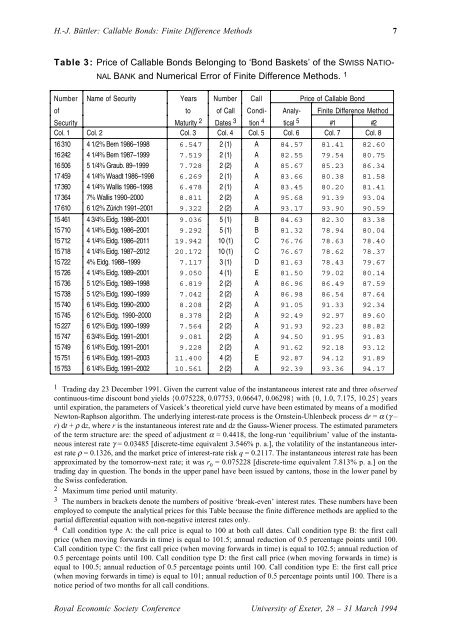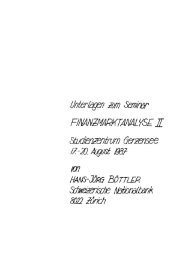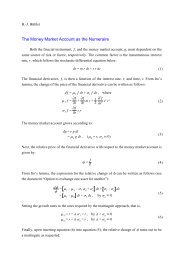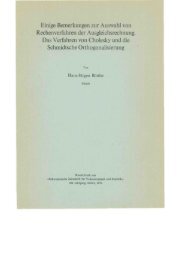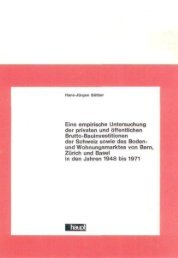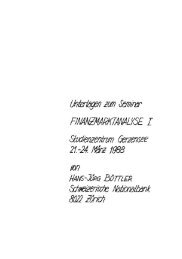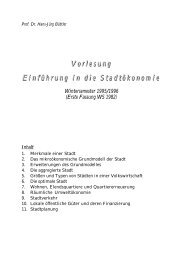Callable Bond/EJ/e
Callable Bond/EJ/e
Callable Bond/EJ/e
You also want an ePaper? Increase the reach of your titles
YUMPU automatically turns print PDFs into web optimized ePapers that Google loves.
H.-J. Büttler: <strong>Callable</strong> <strong>Bond</strong>s: Finite Difference Methods 7<br />
Table 3: Price of <strong>Callable</strong> <strong>Bond</strong>s Belonging to ‘<strong>Bond</strong> Baskets’ of the SWISS NATIO-<br />
NAL BANK and Numerical Error of Finite Difference Methods. 1<br />
Number Name of Security Years Number Call Price of <strong>Callable</strong> <strong>Bond</strong><br />
of to of Call Condi- Analy- Finite Difference Method<br />
Security Maturity 2 Dates 3 tion 4 tical 5 #1 #2<br />
Col. 1 Col. 2 Col. 3 Col. 4 Col. 5 Col. 6 Col. 7 Col. 8<br />
16 310 4 1/2% Bern 1986–1998 6.547 2 (1) A 84.57 81.41 82.60<br />
16 242 4 1/4% Bern 1987–1999 7.519 2 (1) A 82.55 79.54 80.75<br />
16 506 5 1/4% Graub. 89–1999 7.728 2 (2) A 85.67 85.23 86.34<br />
17 459 4 1/4% Waadt 1986–1998 6.269 2 (1) A 83.66 80.38 81.58<br />
17 360 4 1/4% Wallis 1986–1998 6.478 2 (1) A 83.45 80.20 81.41<br />
17 364 7% Wallis 1990–2000 8.811 2 (2) A 95.68 91.39 93.04<br />
17 610 6 1/2% Zürich 1991–2001 9.322 2 (2) A 93.17 93.90 90.59<br />
15 461 4 3/4% Eidg. 1986–2001 9.036 5 (1) B 84.63 82.30 83.38<br />
15 710 4 1/4% Eidg. 1986–2001 9.292 5 (1) B 81.32 78.94 80.04<br />
15 712 4 1/4% Eidg. 1986–2011 19.942 10 (1) C 76.76 78.63 78.40<br />
15 718 4 1/4% Eidg. 1987–2012 20.172 10 (1) C 76.67 78.62 78.37<br />
15 722 4% Eidg. 1988–1999 7.117 3 (1) D 81.63 78.43 79.67<br />
15 726 4 1/4% Eidg. 1989–2001 9.050 4 (1) E 81.50 79.02 80.14<br />
15 736 5 1/2% Eidg. 1989–1998 6.819 2 (2) A 86.96 86.49 87.59<br />
15 738 5 1/2% Eidg. 1990–1999 7.042 2 (2) A 86.98 86.54 87.64<br />
15 740 6 1/4% Eidg. 1990–2000 8.208 2 (2) A 91.05 91.33 92.34<br />
15 745 6 1/2% Eidg. 1990–2000 8.378 2 (2) A 92.49 92.97 89.60<br />
15 227 6 1/2% Eidg. 1990–1999 7.564 2 (2) A 91.93 92.23 88.82<br />
15 747 6 3/4% Eidg. 1991–2001 9.081 2 (2) A 94.50 91.95 91.83<br />
15 749 6 1/4% Eidg. 1991–2001 9.228 2 (2) A 91.62 92.18 93.12<br />
15 751 6 1/4% Eidg. 1991–2003 11.400 4 (2) E 92.87 94.12 91.89<br />
15 753 6 1/4% Eidg. 1991–2002 10.561 2 (2) A 92.39 93.36 94.17<br />
1 Trading day 23 December 1991. Given the current value of the instantaneous interest rate and three observed<br />
continuous-time discount bond yields {0.075228, 0.07753, 0.06647, 0.06298} with {0, 1.0, 7.175, 10.25} years<br />
until expiration, the parameters of Vasicek’s theoretical yield curve have been estimated by means of a modified<br />
Newton-Raphson algorithm. The underlying interest-rate process is the Ornstein-Uhlenbeck process dr = α (γ –<br />
r) dt + ρ dz, where r is the instantaneous interest rate and dz the Gauss-Wiener process. The estimated parameters<br />
of the term structure are: the speed of adjustment α = 0.4418, the long-run ‘equilibrium’ value of the instantaneous<br />
interest rate γ = 0.03485 [discrete-time equivalent 3.546% p. a.], the volatility of the instantaneous interest<br />
rate ρ = 0.1326, and the market price of interest-rate risk q = 0.2117. The instantaneous interest rate has been<br />
approximated by the tomorrow-next rate; it was r 0<br />
= 0.075228 [discrete-time equivalent 7.813% p. a.] on the<br />
trading day in question. The bonds in the upper panel have been issued by cantons, those in the lower panel by<br />
the Swiss confederation.<br />
2 Maximum time period until maturity.<br />
3 The numbers in brackets denote the numbers of positive ‘break-even’ interest rates. These numbers have been<br />
employed to compute the analytical prices for this Table because the finite difference methods are applied to the<br />
partial differential equation with non-negative interest rates only.<br />
4 Call condition type A: the call price is equal to 100 at both call dates. Call condition type B: the first call<br />
price (when moving forwards in time) is equal to 101.5; annual reduction of 0.5 percentage points until 100.<br />
Call condition type C: the first call price (when moving forwards in time) is equal to 102.5; annual reduction of<br />
0.5 percentage points until 100. Call condition type D: the first call price (when moving forwards in time) is<br />
equal to 100.5; annual reduction of 0.5 percentage points until 100. Call condition type E: the first call price<br />
(when moving forwards in time) is equal to 101; annual reduction of 0.5 percentage points until 100. There is a<br />
notice period of two months for all call conditions.<br />
Royal Economic Society Conference University of Exeter, 28 – 31 March 1994


